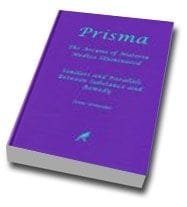The unique qualities of Vermeulen’s Prisma – Homeopathic Materia Medica
- Every remedy is introduced with a quip or a quote, ranging from deadly serious to light-hearted.
- Taken from every available source, the SIGNS section contains summarized information about the substance from which the drug is derived.
- Sources are documented.
- The section MAIN SYMPTOMS is a revised and enlarged version of the ‘Leading Symptoms’ in Synoptic Materia Medica 1.
- The symptoms comprising the RUBRICS section are taken from Synthesis, Edition 7.1.
Prisma Materia Medica points out parallels and similarity between homoeopathic drug pictures and the substances from which they are derived
Quotes from the introduction of Prisma:
- Much has changed since the time that Hahnemann and Hering undertook their provings, not only regarding the criteria of provings but also in terms of the information on substances. Since it is our sole duty to heal the sick, to paraphrase Grimmer, “we cannot afford to ignore intelligent help from any source so long as this aid available is based on law and common sense.”
- The hot debate raging currently over the question whether homoeopathy is scientific or not, appears to make the doctrine of signatures its main scapegoat.
- Hering observes that this very ancient doctrine “has much to recommend it on the grounds of similia” and Clarke states, in the introduction to Magnesia carbonica, that “it is often found that the physical characteristics of substances correspond with their dynamic influences.”
- Based on law and common sense, natural science constitutes the modern version of the ancient doctrine of signatures and here much information can be found about the peculiar features of substances.
Prisma Materia Medica contains the results of many non-homoeopathic experiments which may extend or improve existing drug pictures
Modern research and experiments open up new perspectives. Prejudices can be counterbalanced by more accurate observations. In his Studies of Homoeopathic Remedies, Gibson points out that there are correspondences between the character and behaviour of the “dreaded surucucu snake of South America ” and the characteristics of the Lachesis ‘subject’.
Following older descriptions in homoeopathic literature, the snake is depicted as “an aggressive brute, attacking even human beings without provocation”. The authoritative work Snakes: The Evolution of Mystery in Nature, by biologist Harry W. Greene, however, shows that the bushmaster hardly ever bites, partly because it is unusually timid and partly because it is strictly nocturnal and doesn’t come around human habitations.
Completion and addition are more good reasons for including data from natural sciences into the homoeopathic materia medica
A few examples.
- The recently discovered connection between boron and osteoporosis puts the Borax symptom ‘fear of failing’ into a new perspective.
- The mind-picture of Manganum reveals hardly any specific symptoms. A phenomenon known as ‘manganese madness’- which even has been connected with BSE [mad cow disease] – is not included.
- The bite by the black widow spider [Latrodectus mactans] may cause a syndrome named ‘latrodectism’, much of which is missing in the materia medica.
- Although belonging to entirely different plant families, Plantago [plantain] and Euphrasia [eyebright] have the presence of the rare biological substance aucubin in common. Aucubin is the main active ingredient of ‘anti-smoking compounds’. Plantago is in homoeopathic literature mentioned for that purpose – remedies to increase disgust for tobacco – but Euphrasia is not, despite the fact that two provers developed an aversion to smoking.
- Demographic studies have demonstrated the severe mental and physical effects of ergot poisoning [Secale cornutum].





